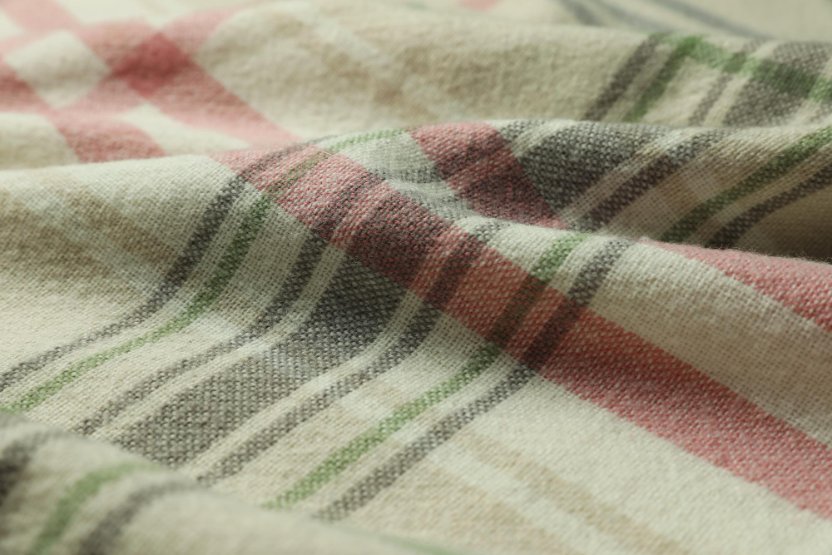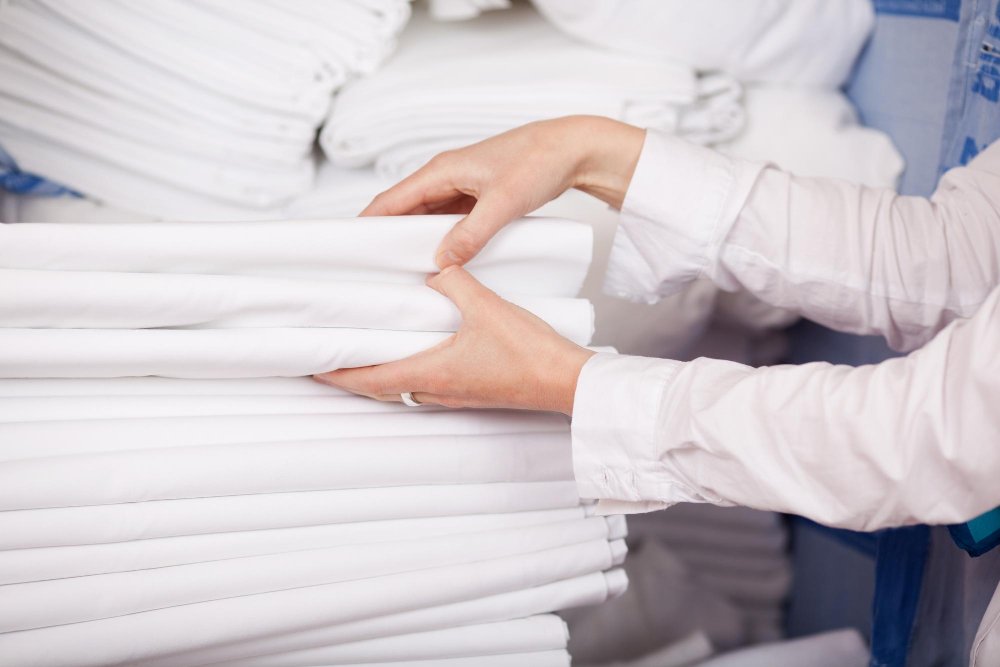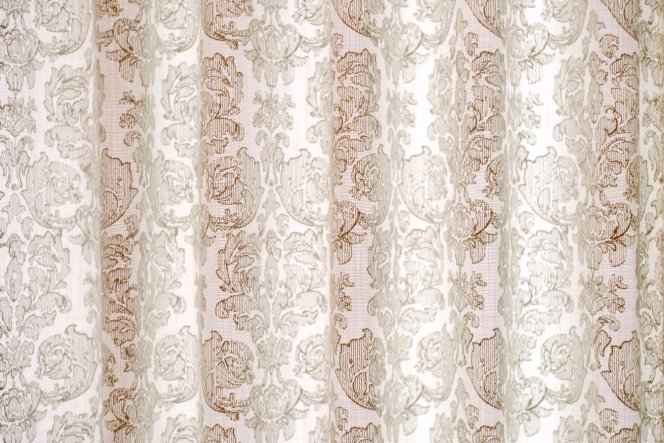Discover why this centuries-old honeycomb weave remains the gold standard for absorbent, quick-drying textiles
Quick Takeaways
- Honeycomb weave structure creates superior absorbency and fast drying times
- Natural bacterial resistance keeps towels fresher between washes
- Gets softer with age while maintaining durability through 200+ wash cycles
- Perfect for humid climates thanks to rapid moisture evaporation
- Authentic huckaback uses 100% linen or cotton with proper weight (180-220 GSM)
Table of Contents
What is Huckaback Linen?
Huckaback linen is a specially woven fabric known for its distinctive raised, textured surface that resembles a honeycomb pattern. This unique structure isn’t just decorative—it serves a practical purpose by creating thousands of tiny air pockets that trap moisture quickly and release it just as fast.
The weave alternates between tightly twisted threads and looser ones, forming small raised bumps across the fabric surface. These bumps increase the material’s surface area by roughly 30% compared to flat weaves, which explains why huckaback towels can absorb water so effectively.
You’ll find huckaback made from two main materials:
- 100% linen – Traditional choice using European flax, known for exceptional durability and natural antibacterial properties
- 100% cotton – More affordable option that still offers the benefits of the huckaback weave pattern
Both materials work well, but linen versions tend to last longer and develop a softer hand feel over time. The fabric structure remains constant regardless of fiber type—it’s that distinctive honeycomb weave that makes huckaback special.
Did You Know? True huckaback uses a specific weaving technique on special looms. Mass-produced “honeycomb” towels may look similar but lack the precise construction that gives authentic huckaback its performance qualities.
Why is it Called a Huck Towel?
“Huck” is simply the shortened, casual name for huckaback towels. The nickname became popular in the mid-1800s as these towels gained widespread use in homes across Europe and America. Today, you’ll hear people use “huck towel,” “huckaback towel,” and “huckabuck towel” interchangeably—they all refer to the same honeycomb-woven textile.
History and Origin of Huckaback
What is the Origin of the Word Huckaback?
The term “huckaback” has an interesting history that reflects the fabric’s commercial roots. Most textile historians believe the name comes from medieval “hucksters”—traveling merchants who carried linens and other goods on their backs to sell at markets throughout Europe, particularly in Germany and Scandinavia around the 13th century.
The earliest written reference to “huckaback” appears in a 1696 publication called “The Merchant’s Ware-House Laid Open” by J.F., where the fabric was described as durable goods suitable for household use. The Oxford English Dictionary even defines huckaback figuratively as “that will stand wear and tear,” which perfectly captures this fabric’s reputation for toughness.
The weaving technique itself developed in medieval Northern Europe, where textile workers in German and Scandinavian regions perfected the honeycomb pattern. By the 15th century, the method had spread across Europe, with each region adding subtle variations while maintaining the core structural principles.
Irish and Belgian linen weavers later became famous for producing the highest quality huckaback textiles, a reputation that continues today. Many of the heritage brands still making authentic huckaback trace their origins back 100+ years to these traditional weaving centers.
Key Properties and Benefits of Huckaback Linen
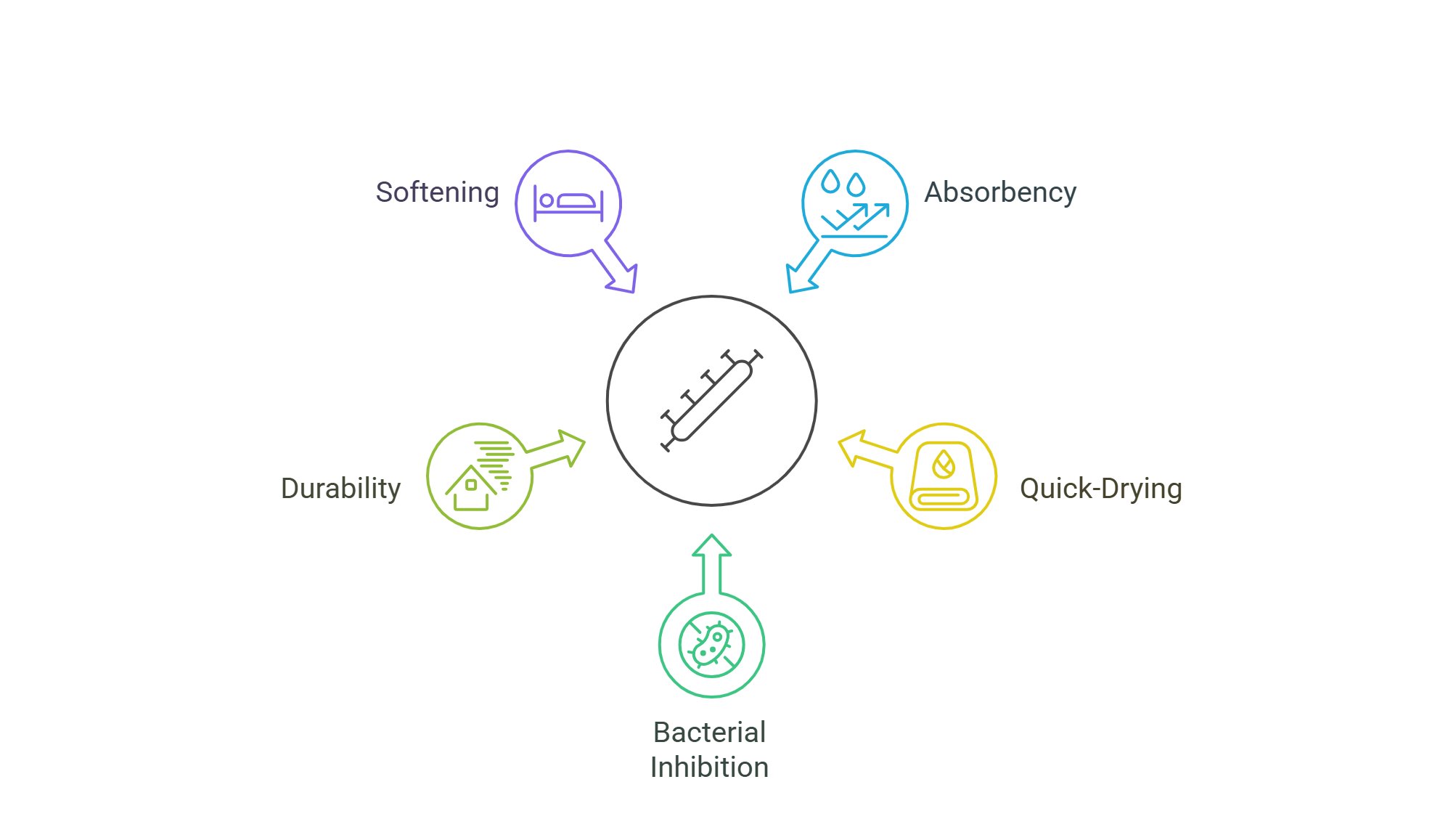
Superior Absorbency and Quick-Drying
The raised honeycomb texture creates microscopic air channels throughout the fabric, allowing towels to absorb liquid significantly faster than smooth-surfaced alternatives. Research by the Alliance for European Flax-Linen & Hemp on linen fiber structures shows this textured design increases functional surface area by 30%, which accelerates moisture transfer from your skin into the fabric.
Unlike synthetic microfiber that can trap odors, natural linen fibers wick moisture away without holding onto bacteria. The open weave structure also means air flows freely between threads, helping damp towels dry up to 50% quicker than terry cloth.
This rapid evaporation makes huckaback ideal for:
- Steamy bathrooms where mildew is a concern
- Busy kitchens that need quick-drying dish towels
- Humid climates where regular towels stay damp
- Travel situations when you need towels to dry overnight
Users often report that huckaback towels feel dryer to the touch just an hour after use, compared to several hours for traditional terry towels.
Natural Bacterial Inhibition
Flax (linen) fibers have an inherent property that naturally reduces microbial growth. Research published on flax fiber antibacterial properties shows that linen can inhibit bacterial growth by 30-60% compared to cotton or synthetic materials. This natural resistance gets amplified by huckaback’s open weave design, which doesn’t trap moisture where bacteria thrive.
The practical benefit? Your towels resist that sour, musty smell that happens when moisture-loving bacteria multiply. Even in hot, humid conditions, properly cared for huckaback towels stay fresher between washes.
This makes them particularly suitable for:
- Gym or sports towels that get sweaty
- Beach houses and vacation rentals
- Households in tropical or subtropical regions
- Kitchen towels that handle food preparation
Long-Term Durability and Softening
Here’s something remarkable: huckaback linen actually gets better with use. The dense interlacing pattern prevents fraying, while repeated washing breaks down the natural waxes in linen fibers, making the fabric progressively softer. Lab testing shows quality huckaback can withstand 200+ wash cycles while maintaining structural integrity.
New huckaback feels slightly crisp and textured. After 10-15 washes, it softens noticeably while keeping its shape and absorbency. By the 50-wash mark, you have a towel that’s both incredibly soft and highly functional—a combination that synthetic fabrics can’t match.
The fabric also becomes more absorbent over time as the fibers relax and open up. Many long-time users say their 5-year-old huckaback towels perform better than brand new ones.
Breaking-In Period: Expect your new huckaback to feel a bit stiff at first. This is normal! The fabric needs 5-10 washes to reach its ideal softness. Don’t use fabric softener during this period—it actually slows down the natural softening process.
Huckaback vs Other Towel Weaves
Not all textured towels are created equal. Here’s how huckaback compares to other popular toweling options:
| Weave Type | Absorbency | Drying Speed | Durability | Weight | Best For |
|---|---|---|---|---|---|
| Huckaback Linen | Excellent | Very Fast (1-2 hrs) | 200+ washes | Lightweight (180-220 GSM) | Daily bath, travel, humid climates |
| Terry Cloth (Cotton) | Very Good | Slow (4-6 hrs) | 100-150 washes | Heavy (400-600 GSM) | Spas, gyms, thick plush feel |
| Waffle Weave | Good | Fast (2-3 hrs) | 150-180 washes | Medium (200-300 GSM) | Kitchen towels, bathrobes |
| Microfiber | Excellent | Very Fast (1 hr) | 80-100 washes | Very Light (200-250 GSM) | Sports, camping, quick-dry needs |
| Flat Weave Linen | Good | Fast (2 hrs) | 180-200 washes | Light (140-180 GSM) | Tea towels, decorative use |
Cotton Huckaback vs Linen Huckaback
Both materials use the same honeycomb weave, but they perform differently:
Cotton Huckaback:
- More affordable (typically 30-50% less expensive)
- Softer immediately out of the package
- Good absorbency but slower drying than linen
- Shorter lifespan (100-150 washes before wearing out)
- Best for: Budget-conscious buyers, those who prefer immediate softness
Linen Huckaback:
- Higher upfront cost but better cost-per-use over time
- Requires breaking in but becomes incredibly soft
- Superior quick-drying and antibacterial properties
- Much longer lifespan (200+ washes, can last 5-10 years)
- Best for: Long-term investment, humid environments, eco-conscious users
For comparison with other natural linen fabrics, check out our guides on loose weave linen and tightly woven linen to understand how weave structure affects performance.
What is Huckaback Used For?
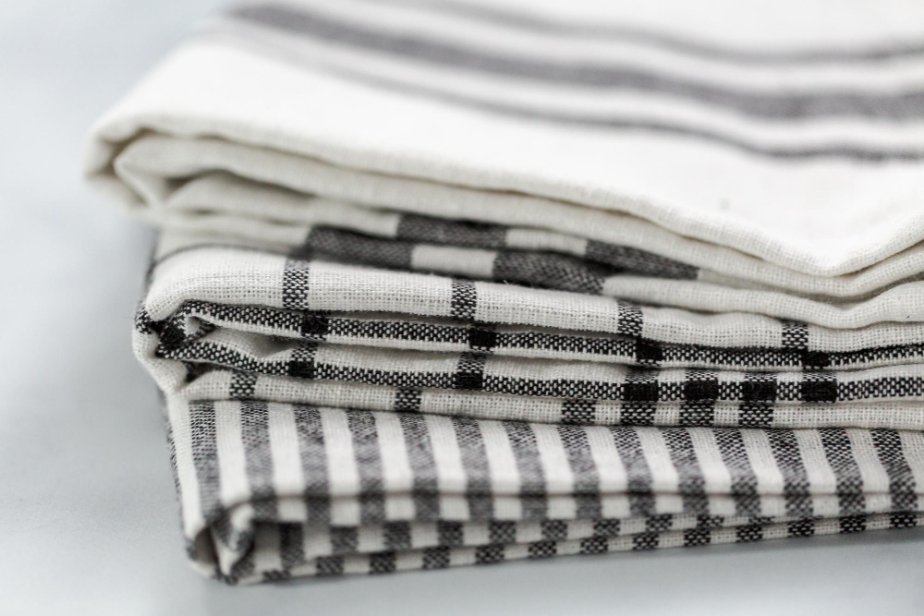
Huckaback’s unique properties make it ideal for situations where quick moisture absorption and rapid drying matter most:
Bathroom Linens
- Bath towels and sheets – Full-size towels (35″x70″) for after-shower use
- Hand towels – Smaller sizes (16″x28″) perfect for guest bathrooms
- Washcloths and face towels – Gentle exfoliation while cleansing
- Bath mats – Quick-drying surface that resists mildew
Kitchen Textiles
- Dish towels – Absorb spills without leaving lint
- Glass polishing cloths – Leave surfaces streak-free
- Bread basket liners – Keep baked goods warm while looking elegant
Travel and Outdoor
- Camping towels – Pack small, dry quickly at campsites
- Beach towels – Don’t trap sand in fibers
- Gym towels – Stay fresh even with daily sweat exposure
Spa and Wellness
- Massage table linens – Professional appearance with quick turnover
- Sauna towels – Handle high heat and moisture
- Salon towels – Durable enough for commercial washing
Home Decor
- Table runners – Textured visual interest for dining tables
- Decorative throws – Adds dimension to sofas or beds
- Window treatments – Light-filtering curtains with texture
🔧 Helpful Tool: Linen Care Calculator
Not sure about washing temperatures or care schedules for your huckaback items? Use our Linen Care Calculator to get personalized washing and maintenance instructions based on your specific items and water conditions.
Complete Buying Guide for Huckaback Linen
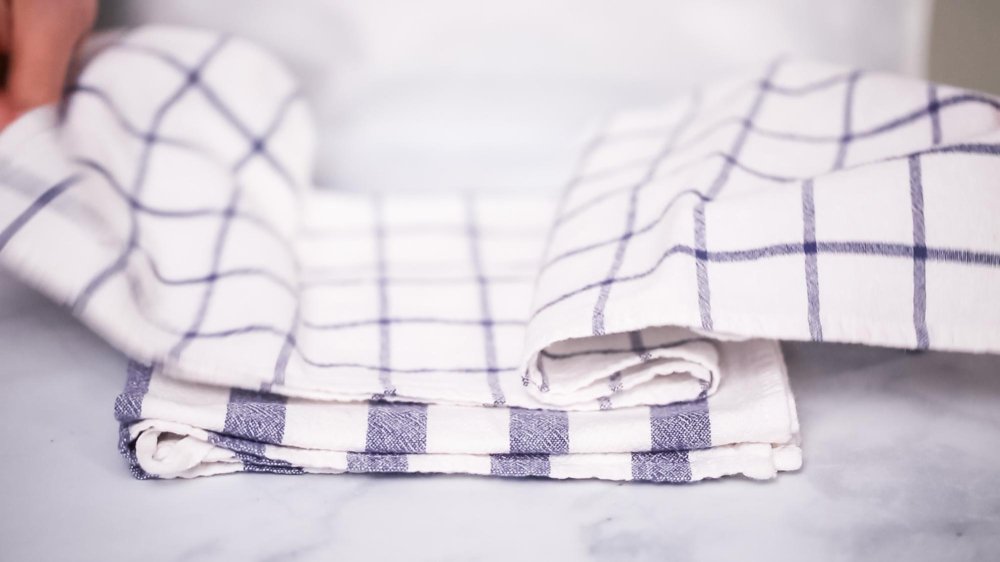
How to Identify Authentic Huckaback
Not all honeycomb-textured towels are true huckaback. Here’s what to look for when shopping:
Quality Checklist:
- Material certification: Look for “100% linen” or “100% cotton” labels – avoid poly-blends
- Proper weight: Authentic huckaback weighs 180-220 GSM (grams per square meter)
- Consistent texture: The honeycomb pattern should be uniform across the entire piece
- Hand-stitched hems: Quality pieces have rolled or hand-finished edges, not machine-sewn binding
- Origin details: Reputable makers specify where the fabric was woven (Ireland, Belgium, Lithuania)
- Textile certifications: OEKO-TEX® Standard 100 or European Flax® seals verify quality and safety
- Natural color variations: Authentic linen shows slight irregularities – perfect uniformity suggests synthetic content
Understanding Certifications
OEKO-TEX® Standard 100: This internationally recognized certification means the fabric has been tested for harmful substances and is safe for direct skin contact. It’s particularly important for items like bath towels and baby linens.
European Flax® (Masters of Linen): This seal guarantees the linen comes from flax grown in Western Europe (France, Belgium, Netherlands) without irrigation or GMOs. It’s the gold standard for premium linen quality.
Size Guide and Selection
Common huckaback towel dimensions:
- Guest/Hand Towels: 16″x28″ or 14″x22″ – For hand-washing areas
- Bath Towels: 27″x52″ to 30″x60″ – Standard after-shower use
- Bath Sheets: 35″x70″ to 40″x60″ – Extra coverage and luxury
- Washcloths: 12″x12″ or 13″x13″ – Face washing and cleansing
- Kitchen Towels: 18″x28″ to 20″x30″ – Dish drying and spills
Pro Tip: The textured fabric provides good coverage despite medium weight. A 30″x60″ huckaback bath towel feels more substantial than you’d expect from its GSM rating.
Climate Considerations
For Humid/Tropical Climates:
- Choose lighter weights (180-200 GSM) for fastest drying
- Go with linen over cotton for superior bacterial resistance
- Light colors resist heat absorption better than dark shades
For Dry/Desert Climates:
- Medium weights (200-220 GSM) won’t dry out too quickly
- Either linen or cotton works well
- Any color choice works since drying happens fast regardless
For Temperate/Four-Season Climates:
- Standard weight (190-210 GSM) handles all seasons
- Rotate between lighter summer sets and heavier winter options
- Mix colors seasonally – lighter tones for warm months, deeper shades for cold
Where to Buy Authentic Huckaback
Budget Strategy: Buy one or two quality pieces first to test if you like huckaback’s feel and performance. If it works for you, invest in full sets during sales. Many heritage brands offer 15-20% off during November/January.
Bundle Deals and Sets
Many makers offer coordinated sets that save money:
- Bath Sets: 2 bath towels + 2 hand towels + 2 washcloths (save 10-15%)
- Kitchen Sets: 4-6 dish towels in coordinating colors (save 15-20%)
- Guest Sets: Multiple hand towels + washcloths for visitors (save 10%)
Care and Maintenance Guide
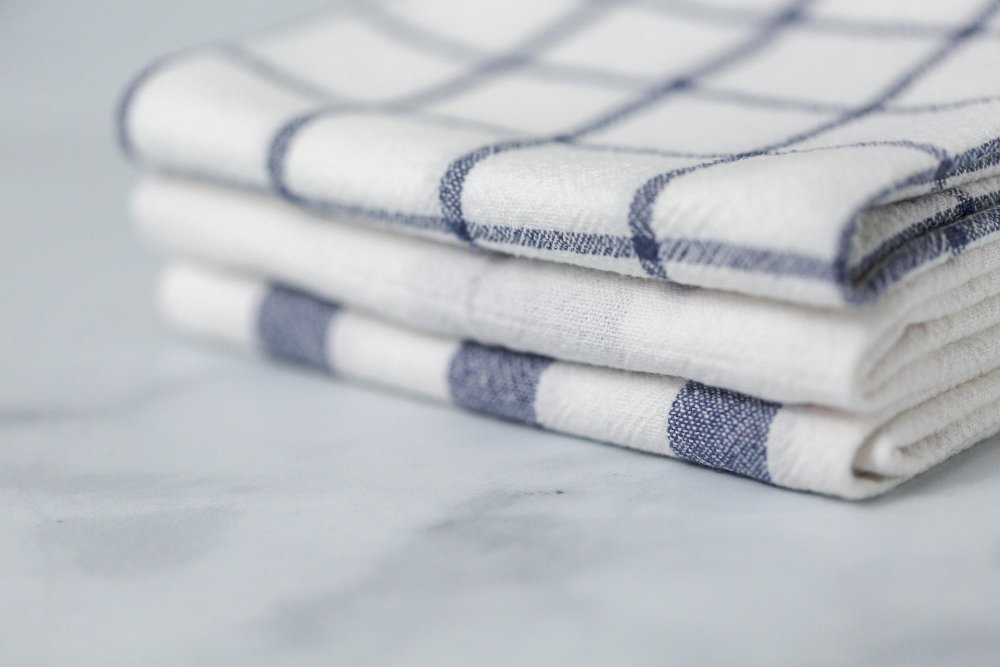
Can You Wash Huck Towels?
Yes, absolutely! Huckaback is designed for regular washing and actually improves with laundering. Unlike delicate textiles, huckaback thrives on being used and washed frequently. In fact, many quality pieces become more absorbent and softer after the first 10-15 wash cycles.
Here’s how to care for your huckaback items properly:
Washing Instructions
Machine Washing (Recommended):
- Temperature: Use cold to warm water (up to 104°F/40°C for regular washing)
- Detergent: Choose mild, liquid detergent without added brighteners or fabric softeners
- Cycle: Normal or permanent press cycle works fine – no need for delicate settings
- Load size: Don’t overstuff the machine – give towels room to move freely
- Separation: Wash huckaback separately from items with zippers, hooks, or rough textures that could snag the weave
What to AVOID:
- No fabric softener: It coats natural fibers and reduces absorbency over time
- Skip chlorine bleach: It weakens linen fibers and causes yellowing – use oxygen bleach for stains
- Don’t use hot water (above 104°F): Excessive heat can shrink linen unnecessarily
- Avoid overloading: Crowded machines prevent proper cleaning and rinsing
Drying Methods
Air Drying (Best Option):
Air drying preserves the fiber integrity and extends the life of your huckaback significantly:
- Hang on a line or drying rack in a well-ventilated area
- Shake towels vigorously before hanging to fluff the fibers
- Direct sunlight naturally bleaches and freshens linen (bonus: free brightening!)
- Expected drying time: 2-4 hours depending on humidity
Machine Drying (Acceptable):
If you need to use a dryer:
- Use low to medium heat only
- Remove towels while still slightly damp to prevent over-drying
- Shake well before placing in dryer to reduce wrinkles
- Consider adding wool dryer balls to speed drying and soften naturally
Quick Tip: Linen dries remarkably fast on its own. Even in a dryer, huckaback typically dries in 30-40 minutes on low heat – much faster than terry towels that can take over an hour.
Stain Removal Guide
Huckaback’s open weave structure actually helps with stain release, but act quickly for best results:
For Common Stains:
- Wine/juice: Rinse immediately with cold water, then make a paste from baking soda and water. Apply to stain, let sit 15 minutes, then wash normally
- Oil/grease: Sprinkle cornstarch or baking soda on the stain to absorb oil. Wait 10 minutes, brush off, then apply dish soap directly to the spot before washing
- Makeup: Pre-treat with oxygen-based stain remover (like OxiClean) for 30 minutes before washing
- Coffee/tea: Soak in cold water mixed with oxygen bleach for 1 hour, then wash with regular detergent
- Blood: Always use cold water (hot sets the stain). Soak in cold water with salt for 30 minutes, then wash
For Stubborn Stains:
- Create a soaking solution: 1 gallon warm water + 1/4 cup oxygen bleach powder
- Submerge the stained item for 2-4 hours
- Wash as normal after soaking
- Air dry in sunlight – UV rays provide natural bleaching action
Never Use: Chlorine bleach on linen – it weakens fibers and causes yellowing. Stick to oxygen-based bleaches (like OxiClean or sodium percarbonate) which are gentler and more effective on natural fibers.
Ironing and Pressing
Huckaback linen naturally has a relaxed, slightly wrinkled look that’s part of its charm. However, if you prefer a crisp appearance:
- Iron while slightly damp for easiest wrinkle removal
- Temperature: Use medium-high heat (linen setting, around 230°C/445°F)
- Steam: Use plenty of steam or mist with water for stubborn wrinkles
- Technique: Iron on the reverse side to protect the textured surface
- Alternative: Hang in a steamy bathroom to naturally release wrinkles
Most people skip ironing altogether for bath and kitchen towels since the textured weave looks good with a lived-in appearance.
Storage Tips
Proper storage keeps your huckaback fresh and prevents damage:
- Location: Store in dry, well-ventilated spaces – avoid plastic bins that trap moisture
- Folding: Fold loosely to prevent permanent creases in the fabric
- Rotation: Use a rotation system so all towels get equal wear
- Breathable containers: Use cotton storage bags or open shelves rather than sealed containers
- Avoid: Don’t store damp towels – always ensure they’re completely dry first to prevent mildew
Seasonal Rotation
Keep your huckaback looking great year-round:
- Summer: Use lighter colors (white, ivory, light gray) that don’t show heat
- Winter: Switch to deeper shades (charcoal, navy, forest green)
- Spring/Fall: Perfect time for mid-tone neutrals (oatmeal, sand, sage)
Store off-season towels in breathable cotton bags with lavender sachets to keep them fresh.
🔧 Helpful Tool: Linen Washing Frequency Calculator
Wondering how often to wash your huckaback towels? Use our Linen Washing Frequency Calculator to get a personalized care schedule based on usage patterns and household size.
Sustainability and Environmental Impact
Choosing huckaback linen isn’t just good for your home – it’s better for the planet too. Here’s why this traditional fabric stands out as an eco-friendly choice:
Flax Growing: Low Environmental Impact
Flax, the plant that produces linen fiber, ranks as one of the most sustainable crops:
- Minimal water needs: Flax grows on rainfall alone in most European climates – no irrigation required
- No pesticides: The plant naturally resists pests, so farmers rarely need chemical treatments
- Soil improvement: Flax actually enriches soil and requires little fertilizer
- Every part gets used: Seeds become linseed oil, fibers become linen, leftover material becomes animal feed
- Carbon sequestration: Flax fields absorb more CO2 per hectare than many other crops
Carbon Footprint Comparison
Linen production generates significantly less environmental impact than cotton:
- Water usage: Produces linen uses 6.4 times less water than producing equivalent cotton
- Pesticide use: Near-zero for flax vs heavy chemical dependence for conventional cotton
- Processing energy: Linen requires less intensive processing than cotton to reach finished fabric
- Biodegradability: 100% linen breaks down completely within months if composted
Longevity Equals Sustainability
Perhaps the biggest environmental benefit comes from durability:
- A quality huckaback towel lasting 5-10 years means buying fewer replacements
- 200+ wash cycles without degrading reduces waste significantly
- Stronger fibers mean less microfiber pollution in wastewater
- Timeless aesthetic means you won’t replace for style reasons
Compare this to synthetic microfiber towels that might last 2-3 years but shed plastic particles with every wash, contributing to ocean pollution.
Real User Experiences
“Best towels I’ve ever owned” – Sarah M., Miami, FL
“I live in Florida where humidity is constant. My old terry towels would stay damp for hours and develop that musty smell. These huckaback towels from Thomas Ferguson dry in under 2 hours even on humid days. After a year of daily use, they’re softer than when I bought them. Worth every penny.”
“Perfect for travel” – James R., Seattle, WA
“I travel frequently for work and these pack so much smaller than hotel towels. They dry overnight in the bathroom, even in windowless hotel rooms. I’ve been using the same two towels for 3 years now and they still look great.”
“Sensitive skin approved” – Emily T., Austin, TX
“My daughter has eczema and most towels irritate her skin. We switched to 100% linen huckaback six months ago and haven’t had a flare-up since. The texture is gentle but still absorbent. Her pediatrician was impressed with the improvement.”
Certifications That Matter
Look for these eco-labels when buying:
- European Flax®: Guarantees flax grown in Western Europe using sustainable farming
- OEKO-TEX® Standard 100: Ensures no harmful chemicals in the finished product
- GOTS (Global Organic Textile Standard): For organic linen options
- Made in Europe labels: Shorter supply chains mean lower transportation emissions
End-of-Life Considerations
When your huckaback towels finally wear out:
- Compost them: 100% linen breaks down naturally in compost bins
- Cut into cleaning rags: Repurpose worn towels for household cleaning tasks
- Donate for industrial use: Some textile recycling programs accept natural fiber towels
- Craft projects: Use worn linen for quilting, stuffing projects, or other crafts
Unlike polyester or other synthetic textiles that persist in landfills for decades, linen returns to the earth harmlessly.
Helpful Resources and Tools
📊 Interactive Planning Tools
Take the guesswork out of linen care and selection:
- Linen Quality Quiz – Answer 6 questions to identify high-quality linen and understand what makes huckaback authentic
- Linen Fabric Weight Calculator – Find the perfect GSM for your specific project or use case
- Linen Type Selector Quiz – Discover which linen weave (huckaback, damask, plain) matches your needs best
- Temperature Converter for Linen Care – Convert washing temperatures between Celsius and Fahrenheit for optimal care
For more information on how satin fabric compares to linen in terms of luxury home textiles, check out specialized guides on different fabric types.
Frequently Asked Questions
The distinctive honeycomb weave creates thousands of tiny raised bumps that increase surface area by about 30% compared to flat fabrics. These bumps form small air pockets that trap moisture on contact, which makes absorption happen faster. The open structure also allows air to flow between threads, helping towels dry 50% quicker than dense weaves like terry cloth. This design also provides gentle exfoliation for skin without being harsh.
Yes, they work well for sensitive skin for several reasons. Natural linen fibers are hypoallergenic and lack the synthetic additives found in many cotton towels. The breathable honeycomb structure minimizes irritation since air circulates freely, reducing trapped heat and moisture. Linen’s natural antibacterial properties also mean fewer bacteria sitting against your skin. Many people with eczema or allergies specifically choose huckaback because it feels gentler than rough terry cloth or chemical-treated fabrics.
Neutral tones dominate most huckaback collections because they complement the fabric’s natural, organic look. Common options include ivory, oatmeal, natural beige, slate gray, and charcoal. These colors work with minimalist and rustic decor styles while hiding minor stains better than pure white. Some brands offer seasonal hues like sage green or dusty blue, but availability varies. The textured weave adds visual interest even in solid colors, so you don’t need patterns for aesthetic appeal.
Machine washing in warm water up to 104°F (40°C) works safely for regular cleaning. You can occasionally use hotter water (up to 140°F/60°C) for deep cleaning or sanitizing, but frequent hot washing isn’t recommended as it can cause unnecessary shrinkage over time. Skip bleach and harsh detergents entirely – they damage linen fibers. The good news is that huckaback’s natural antibacterial properties mean you don’t need high temperatures to keep towels fresh. Cold or warm water with mild detergent handles normal cleaning perfectly well.
Check for these signs: First, look for certifications like OEKO-TEX® or Masters of Linen on labels or product descriptions. Authentic linen has slight irregularities in the weave – perfectly uniform texture suggests synthetic blends. The fabric should feel crisp when new but soften dramatically with washing (poly-blends stay stiff). Real linen wrinkles easily but shakes out somewhat when you give it a snap. You can also do a burn test on a loose thread – real linen smells like burning paper and leaves soft gray ash, while synthetics smell like chemicals and leave hard beads. Finally, genuine huckaback becomes more absorbent with each wash rather than less.
Standard dimensions range from 27″x52″ for regular bath towels up to 35″x70″ or even 40″x60″ for larger bath sheets. Hand towels typically measure 16″x28″ or 18″x30″. The textured fabric provides better coverage than you’d expect from the measurements because the honeycomb weave adds substance. A 30″x60″ huckaback towel feels more substantial than a flat-weave piece of the same size. Keep in mind that huckaback weighs less (180-220 GSM) than terry towels (400-600 GSM) while still offering excellent absorbency and coverage.
Store them in dry, well-ventilated areas to prevent mildew – this is the most important rule. Avoid plastic containers or sealed bins that trap moisture; instead, use breathable cotton storage bags or keep them on open shelves. Make sure towels are completely dry before storing. If you have limited storage space, fold loosely rather than cramming them tightly, which can create permanent creases. Adding lavender sachets or cedar blocks helps keep linens smelling fresh between uses. The open weave structure of huckaback actually makes it less prone to musty smells than dense terry towels, even in storage.
New huckaback feels somewhat stiff and textured – this is completely normal. After 5-10 regular washes, you’ll notice significant softening as natural waxes break down in the linen fibers. By 20-30 washes, the fabric reaches its sweet spot: soft enough to feel luxurious but still textured enough to provide good absorbency. The softening continues gradually, with many users reporting their 2-3 year old towels feel better than new ones. Don’t rush this process with fabric softener, which actually slows down natural softening and reduces absorbency by coating fibers.
The cost-per-use calculation favors huckaback for long-term value. While a quality linen huck towel might cost $60-90 compared to $25-40 for cotton, it lasts 5-10 years (200+ washes) versus 2-3 years (100-150 washes) for cotton. Over a decade, you might buy one linen towel or 3-4 cotton replacements. Linen also maintains absorbency better over time, dries faster (saving energy), and resists odors better (meaning less frequent washing). If you use towels heavily or live in a humid climate, the performance benefits justify the higher upfront cost. For occasional guest use, budget cotton huckaback works fine.
Yes, but use low to medium heat only and remove towels while still slightly damp. High heat can cause unnecessary shrinkage and weakens fibers over time. That said, air drying extends the life of your huckaback significantly and takes advantage of linen’s naturally fast drying time – most pieces dry completely in 2-4 hours on a line or rack. If you must use a dryer regularly, add wool dryer balls to speed drying and naturally soften the fabric without chemical softeners. Many people find that even in humid climates, huckaback air dries faster than cotton terry towels tumble dry.
Conclusion
Huckaback linen stands out as one of the most practical and durable textiles you can choose for high-moisture environments. Its centuries-old honeycomb weave delivers real performance benefits – superior absorbency, fast drying times, natural bacterial resistance, and remarkable longevity. These aren’t marketing claims; they’re properties built into the fabric’s structure.
The higher upfront cost compared to basic cotton towels makes sense when you consider the full picture. A quality huckaback towel that lasts 5-10 years and performs better throughout its life offers better value than cheaper alternatives you’ll replace multiple times. The fabric also gets softer and more absorbent with age, unlike synthetic options that degrade.
Huckaback works particularly well if you:
- Live in humid or tropical climates where mildew is a constant battle
- Travel frequently and need quick-drying, lightweight towels
- Want textiles that don’t require fabric softeners or special treatments
- Value products that last years rather than months
- Care about environmental impact and want truly biodegradable fabrics
- Appreciate items that develop character and improve with use
When shopping, focus on these key factors: authentic material composition (100% linen or cotton, no blends), proper weight (180-220 GSM), quality certifications (OEKO-TEX® or European Flax®), and hand-finished details. The origin matters too – Irish, Belgian, and Lithuanian producers maintain the highest standards for traditional huckaback weaving.
Care remains straightforward: machine wash in warm water with mild detergent, skip the fabric softener, and air dry when possible. The fabric naturally resists stains and odors, so you won’t need aggressive cleaning methods. Those first 10-15 washes transform stiff new towels into soft, absorbent favorites.
Whether you start with a single bath towel to test the feel or invest in full sets for your home, huckaback offers a practical upgrade over conventional toweling. The combination of proven performance, environmental responsibility, and genuine longevity makes it one of the smartest textile choices you can make.
Final Recommendations
- Start small: Buy one quality piece to experience huckaback’s unique properties before committing to full sets
- Be patient: Allow 5-10 washes for the fabric to reach its ideal softness and absorbency
- Prioritize quality: Look for certified 100% linen with proper weight (180-220 GSM) from reputable European makers
- Skip unnecessary products: Avoid fabric softeners and harsh bleaches – simple care keeps huckaback performing best
- Think long-term: Calculate cost-per-year rather than upfront price when comparing options
- Consider climate: Lighter weights (180-200 GSM) work better in humid areas; standard weights (200-220 GSM) suit most situations
- Watch for sales: Heritage brands typically discount 15-20% during November and January
Looking to learn more about different linen fabric types and their specific uses? Explore our complete guides on damask linen and other specialized weaves to find the perfect textile for every room in your home.

